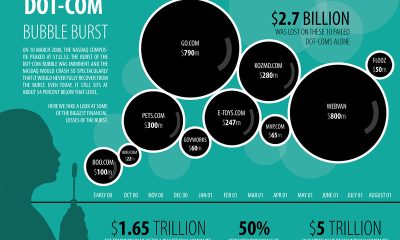Business
What women need to know so they can start investing
A research study found out that women are less likely to invest than men due to a lack of confidence when it comes to finance and investing.

With my experience as a multi-decade investor, former professional portfolio manager and university investments instructor, I will reveal easy to implement strategies to build wealth for women (and men too).
Research by Prudential found that women worry more about risk than men. I get it, despite investing for decades, I’m scared of risk too.
Women report that they lack confidence in finances too. Even though in multiple studies, women are more successful investors than men.
Women, investing is so simple, once you learn the basics, you’ll wonder why you haven’t started earlier, or invested more.
So, put aside your fear, learn a few investing basics, and get started building your financial future.
Women, investing is as easy as pie.
Traditional wisdom recommends looking at your total investable assets like a pie. Put the largest piece of pie — up to 80 percent in stock investments and watch your portfolio surge.
Investing 101 for women
Long term, investing in stock and bond funds is a brilliant way to build wealth.
But first, know your investment history.
Broad stock market indexes have returned more than nine percent annually over long periods of time. In fact, from 1928 to 2017, the average stock market return was 9.65 percent. Yet, don’t let this long turn return fool you. Embedded in the glorious long-term stock market returns are some horrible losing years.
Long-term investment returns
| Year | Stock Market
(S&P 500 w dividends) |
Cash
3-month Treasury Bill |
Bonds
10-Year Treasury Bond |
| 1928-2017 | 9.65 percent | 3.39 percent | 4.88 percent |
| 1968-2017 | 10.05 percent | 4.77 percent | 6.76 percent |
| 2008-2017 | 8.42 percent | 0.41 percent | 3.86 percent |
Data source: NYU Stern School of Business
From 2002 to 2011, the stock market returned 2.88 percent, in contrast with the historical long-term average of 9.65 percent. And if you were savvy enough to begin investing in 1968. Those dollars would have grown an annualized 10.05 percent through 2017.
Women, here’s what this means for you.
In reality, most investors do not achieve an average annualized return over time on their long term stock investments.
The typical investor, due to fear, greed, or a belief that she can outperform the market will buy and sell various individual stocks and managed mutual funds. When stocks are on a normal cyclical downturn, investors get scared, and sell. Conversely, during cyclical stock return upswings, investors, afraid of missing the boat buy as the markets hit a peak. This type of behavior leads to buying high and selling low.
According to Barber, UC Davis and Odean, UC Berkeley in the “Behavior of Individual Investors”, individual investors:
1. Underperform standard benchmarks (e.g., a low cost index fund).
2. Sell winning investments while holding losing investments (the “disposition effect”).
3. Are heavily influenced by limited attention and past return performance in their purchase decisions.
4. Engage in naïve reinforcement learning by repeating past behaviors that coincided with pleasure while avoiding past behaviors that generated pain.
5. Tend to hold undiversified stock portfolios.
These behaviors damage your long term net worth.
So, although over long periods of time investments averaged over 9 percent annually, most investors do not achieve those same returns.
How to combat investment underperformance
The research is abundantly clear that it is extremely difficult to beat the returns of the overall market. Even exceptional mutual fund managers who outperform the major stock market indexes before expenses, fail to surpass their benchmark indexes when expenses are factored in.
Sure there are exceptions, Warren Buffett, Peter Lynch, and George Soros are extraordinary investors. Chances are, you’re not one of them. Plus, there are excellent women investors as well!
In reality, the majority of highly compensated managed mutual fund managers fail to outperform their market benchmarks.
So, if most investors fail to outperform the simple stock market indexes, what should women investors do?
Here, the question is what you should invest in?
The best personal investment strategy for women (and men too)
Women, here’s how to win at investing:
1. Invest for the long term
If you cannot leave your money in a stock index fund, for at least 8-10 years, do not invest. Markets are volatile and over the short term, your returns are random. Over the long term if you believe U.S. and global companies will grow and prosper, then their underlying stocks will advance as well.
2. Cut investment expenses to the bone
Realize that investment expenses are taken off the top. If you invest in a managed mutual fund charging 1 percent per year, then out of every $1,000 you invest, only $990 is going towards building wealth. And that’s not just in year one, that’s every year, that 1 percent is taken out. Thus, if the fund loses 3 percent one year, you lose 4 percent.
Go with the lowest expense mutual fund or Exchange Traded Fund (ETF) you can find. For example, VTI, Vanguard Total Market Index ETF charges, 0.05 percent per year while the category average is 0.33 percent. Less money toward annual management fees means more money in your pocket.

Fear is common among women (and men) investors. But don’t let that apprehension kill your potential in investing. (Source)
3. Don’t fight the market
Accept the fact that it is highly unlikely that you will beat the market, so choose highly diversified low fee investment funds for your portfolio.
4. Choose your asset allocation carefully
Divide your investment pie among stock index mutual funds or ETFs, and fixed income investments like bonds and cash. Plan your investment pie according to how much risk or volatility you can stomach. If you don’t like the ups and downs in value of stock investments then place a smaller percent in those types of investments. Be aware that the opportunity for greater returns comes from taking on more risk. And more risk means a larger part of your pie invested in stock investments.
If you want free investment management help in designing and managing your investment pie, check out one of my favorite platforms, M1 Finance.
5. Stick with your plan through market downturns
No one has a problem when their investment values surge. The problem comes when fear kicks in and you get scared during market downturns. I know more than a few folks who let fear get the best of them and sold during market downturns only to miss the subsequent rebound. If you sell during a market downturn, you have to be right twice, once when you sell and another time when you buy back in.
Women, become a millionaire in 25 years of investing
Women, start at age 40 and become a millionaire by age 65.
Even if you have not begun investing and have nothing saved at age 40, it is possible to reach $1,000,000 by age 65. You invest $1,236 per month in a portfolio equally divided between a U.S. stock index fund, an international stock index fund, and a Treasury Inflation Protected Securities (TIPS) fund.
Assume historical returns prevail. If you earn 6.9 percent annually, then at the end of 25 years, your $370,800 investment will be worth $1,000,000.
Of course, if you start investing younger, you can achieve $1,000,000 with less money.
Start at age 25 and you only need to invest $385 per month to achieve $1,000,000 by retirement. And if your employer kicks into your 401k retirement account, you can invest less and still reach $1,000,000 or more by retirement.
Realize that fear is normal. But, don’t let your apprehension stop you from wealth building.
Start investing today to take care of your financial tomorrow.
Women investing resources
Here’s some help to get you started with your investing:
1. Free microbook; How to Invest and Grow Your Wealth
2. Free budgeting, cash management, retirement planning, investing dashboard (I use this myself). Sign up required. Sponsored by Personal Capital.
3. Investment manager with low fees (not) for women only; Ellevest.
What is your personal investment strategy? How is it working out?
—
DISCLAIMER: This article expresses my own ideas and opinions. Any information I have shared are from sources that I believe to be reliable and accurate. I did not receive any financial compensation in writing this post, nor do I own any shares in any company I’ve mentioned. I encourage any reader to do their own diligent research first before making any investment decisions.

-

 Impact Investing2 weeks ago
Impact Investing2 weeks agoFrance’s Nuclear Waste Dilemma Threatens Energy Future
-

 Fintech1 week ago
Fintech1 week agoKraken Launches Krak: A Game-Changing Peer-to-Peer Crypto Payment App
-

 Impact Investing3 days ago
Impact Investing3 days agoEuropeans Urge Strong Climate Action Amid Rising Awareness and Support
-

 Cannabis2 weeks ago
Cannabis2 weeks agoRecord-Breaking Mary Jane Fair in Berlin Highlights Cannabis Boom Amid Political Uncertainty


























You must be logged in to post a comment Login